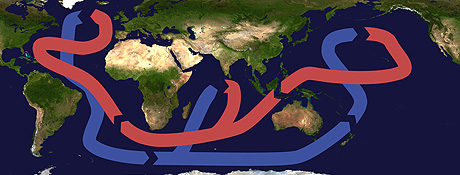Climate Change: The Past of the Atlantic Heat Pump
15 October 2012

Picture: Brisbane, CC BY-SA 3.0
Heat transport in the Atlantic Ocean during the last Ice Age was not weaker, as long assumed, but in fact stronger than it is today. This discovery was made by an international research team led by environmental physicists at Heidelberg University. The scientists used ultra-precise measurements of natural radionuclides in ocean sediments to study the ocean’s strength of circulation and uncovered new information about the past of the “Atlantic heat pump”. The results of their research, which are also significant for correctly predicting climate models, were published in the journal “Nature Geoscience”.
“Thanks to the Gulf Stream and its northern branches, it is much warmer here than at the same latitudes in North America. Without the ocean’s heat transport, which is comparable to that of a million large power plants, temperatures in Northern and Western Europe would be considerably cooler”, explained Dr. Jörg Lippold, lead author of the study from Heidelberg University‘s Institute of Environmental Physics. Europe’s heating system originates in the Gulf of Mexico, where the waters of the ocean warm and flow northeast due to wind and the Earth’s rotation. The water at the surface cools in the process, growing denser, and then sinks in the North Atlantic, where it flows south again in the Ocean’s depths.
“Using two exotic representatives of the periodic table from core samples of Atlantic deep sea sediment, we were able to quantitatively determine this return flow for the first time”, said the Heidelberg researcher. The two isotopes studied, protactinium-231 and thorium-230, are produced from the radioactive decay of uranium found naturally in sea water. While thorium is deposited directly in the sediment at the Ocean’s floor, the protactinium follows the circulation and is carried by the deep sea current from the North Atlantic. The proportion of the two elements in the sediment ergo reflects the strength of the circulation. Around the time of the largest global ice coverage approximately 20,000 years ago, less proctactinium-231 was measured. According to Dr. Lippold, this points to an increase in the Atlantic circulation, which is also supported by model calculations.
Knowing that the Atlantic circulated faster during the Ice Age is important for models used to calculate the future of the world’s climate. The accuracy of the predictions of climate models is assessed in particular by whether they correctly reflect the climate in the past. “The oceans are the key to the Earth’s climate system. There is approximately 50 times more CO2 bound in the Earth’s Oceans than in the atmosphere, with 1,000 times more heat storage capacity“, said Dr. Lippold. “With the Ocean circulating more quickly then, it could also extract and store more CO2 from the atmosphere.”
Understanding these relationships has special significance for major parts of Europe. “If the Ocean warms in the course of climate change and the density of the waters of the North Atlantic drops due to melt water or increased precipitation, the heat pump could weaken. Paradoxically, this could cause cooling in Europe while the rest of the world heats up”, explained the Heidelberg environmental physicist.
The international team’s large-scale study was based on measurements using mass spectrometers and particle accelerators, which were able to detect the required concentrations of a few picograms. The study led by Dr. Jörg Lippold included researchers from Vancouver, Paris, Oxford, Zürich, Lyon, Bristol and Tübingen. Germany’s support of the project came from the German Research Foundation. For more information, go to www.iup.uni-heidelberg.de/institut/forschung/groups/fa/marine
Original publication:
Jörg Lippold, Yiming Luo, Roger Francois, Susan E. Allen, Jeanne Gherardi, Sylvain Pichat, Ben Hickey, Hartmut Schulz: Strength and geometry of the glacial Atlantic Meridional Overturning Circulation. Nature Geoscience (14 October 2012), doi 10.1038/ngeo1608
Contact:
Dr. Jörg Lippold
Institute of Environmental Physics
Phone: +49 6221 54-6385
joerg.lippold@iup.uni-heidelberg.de
Communications and Marketing
Press Office
Phone: +49 6221 542311
presse@rektorat.uni-heidelberg.de

